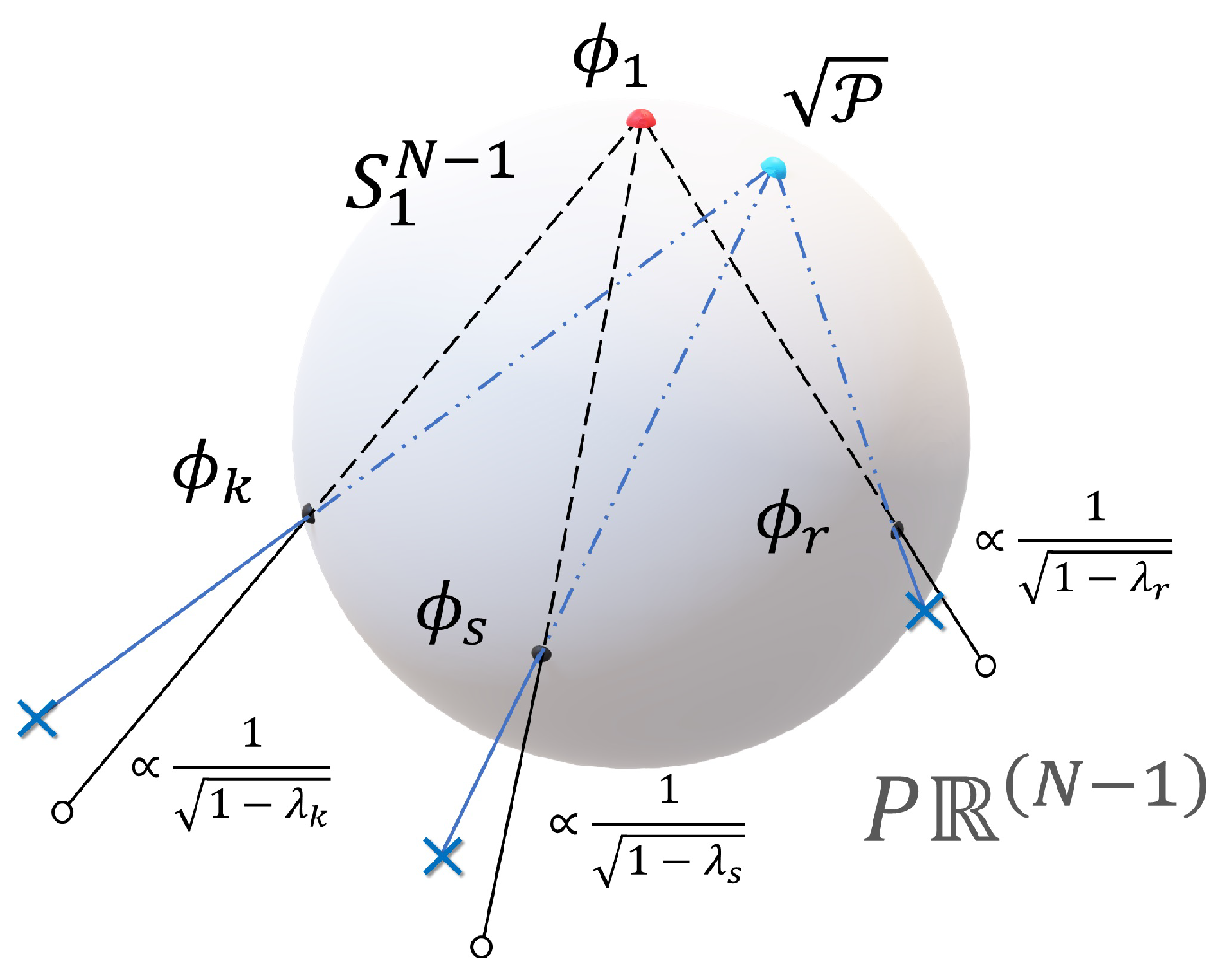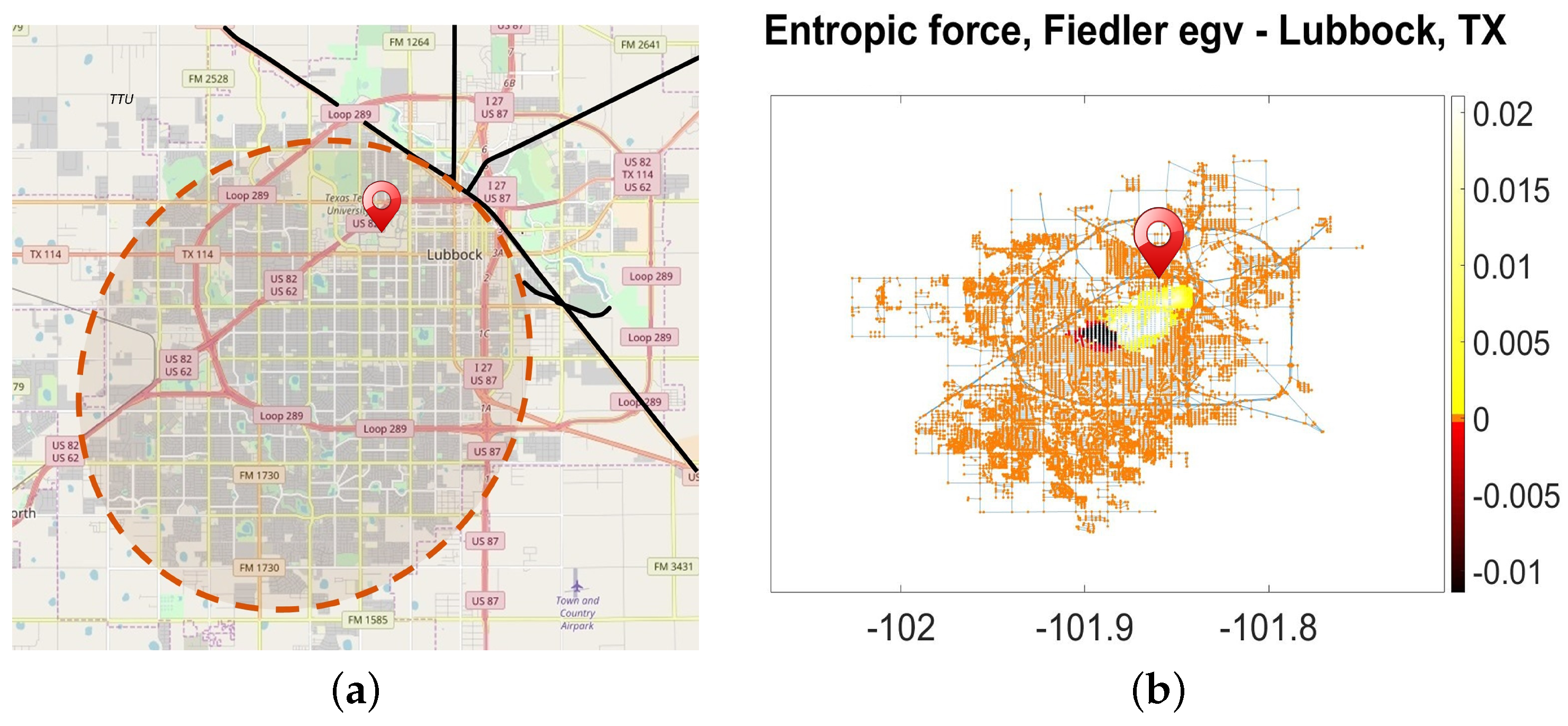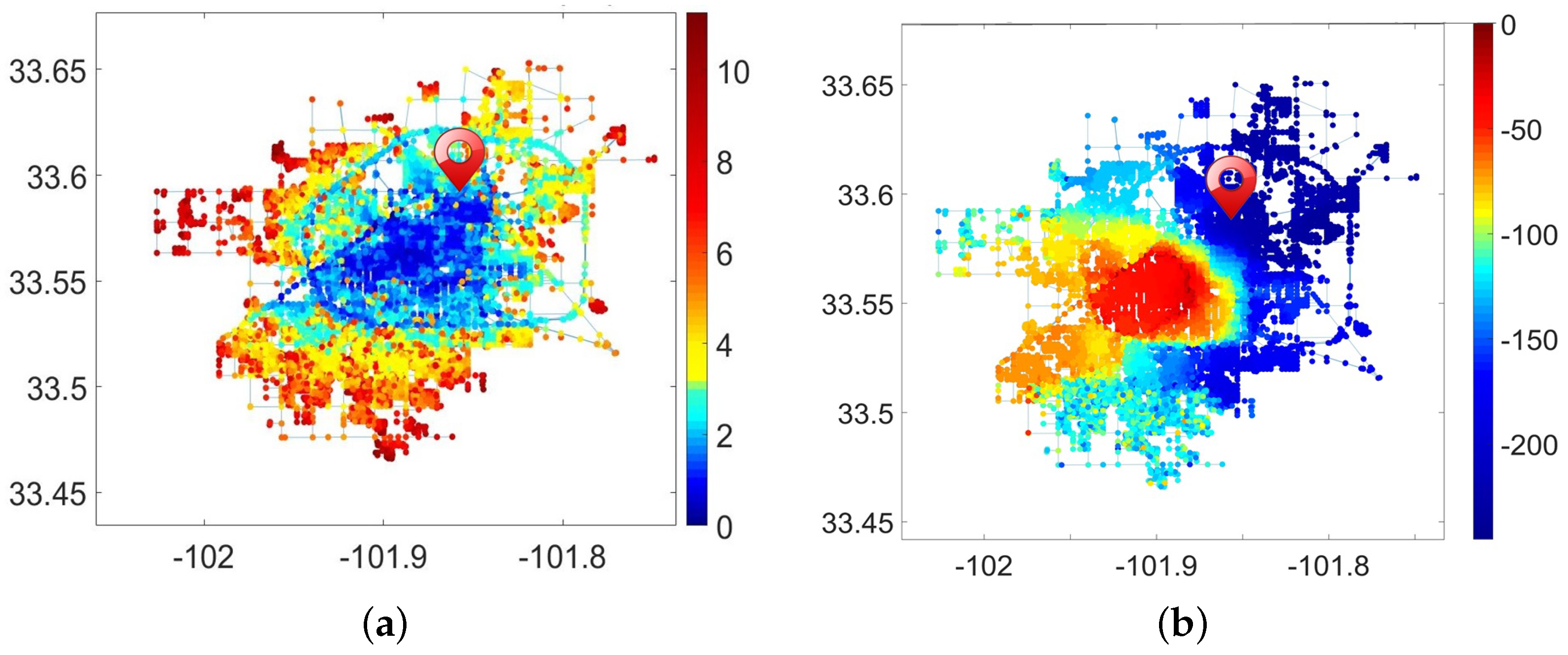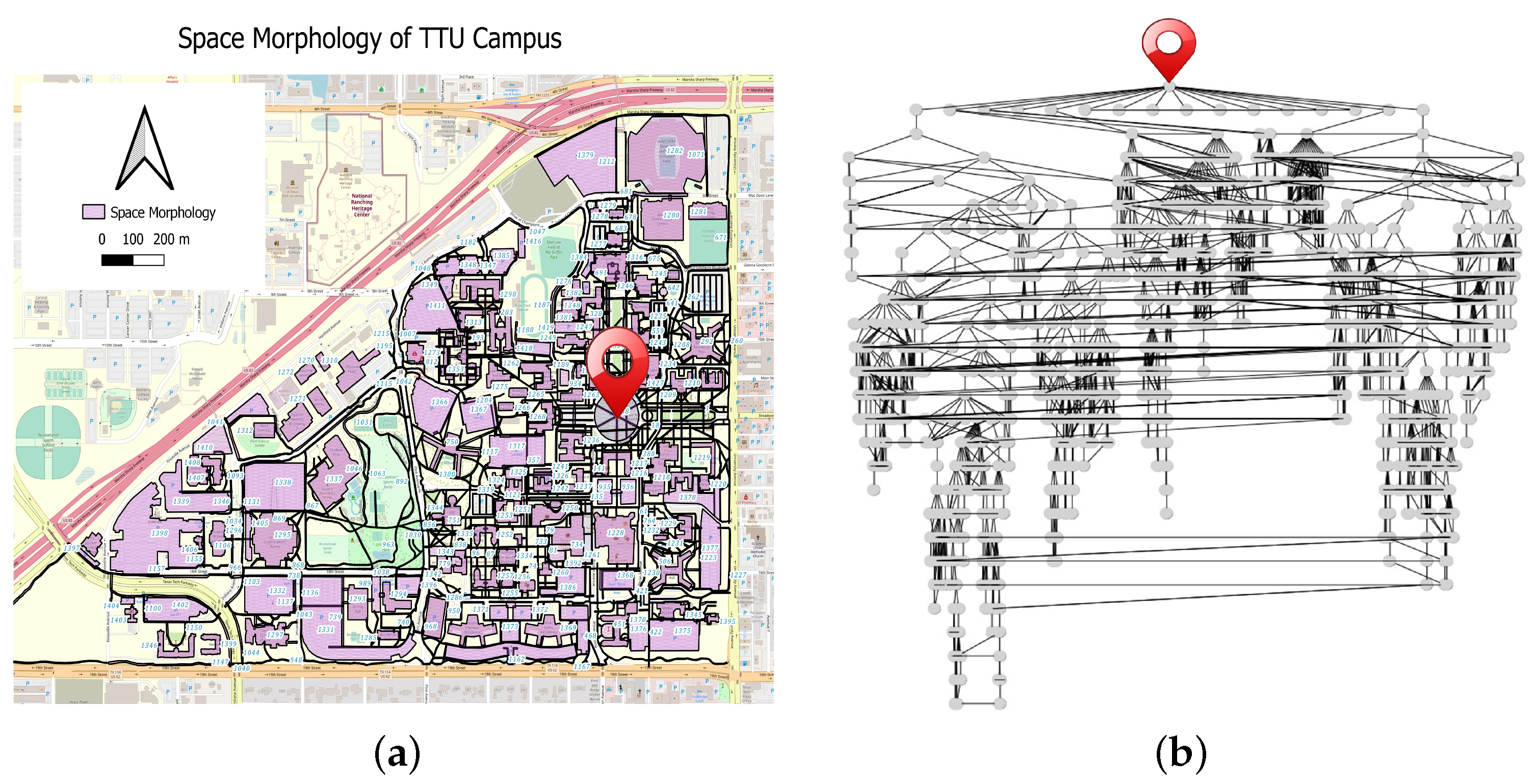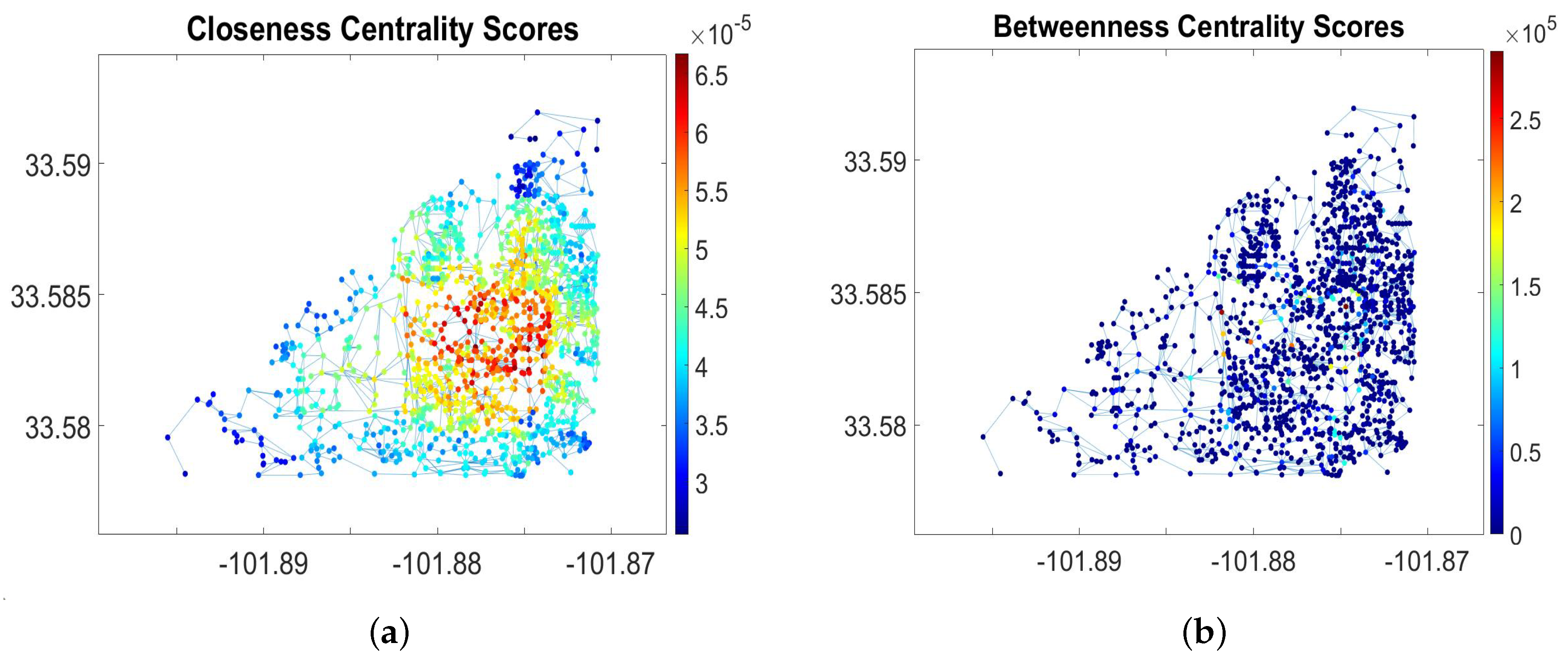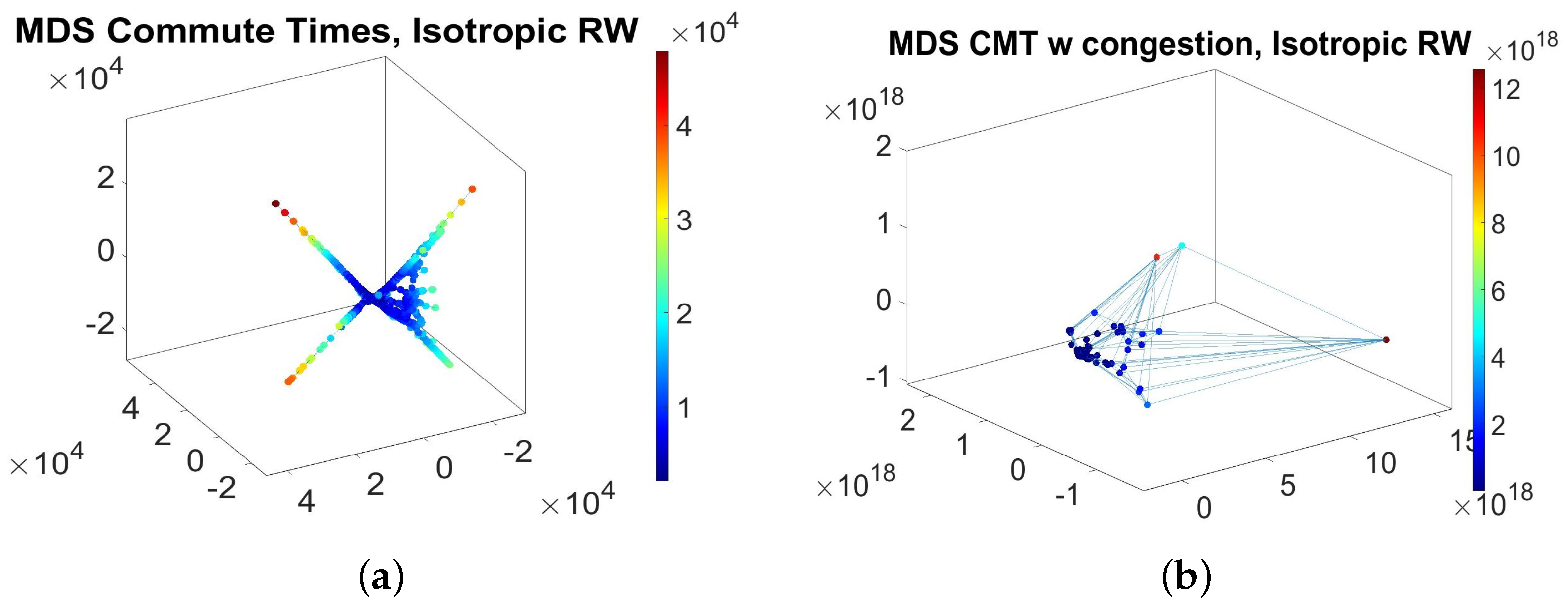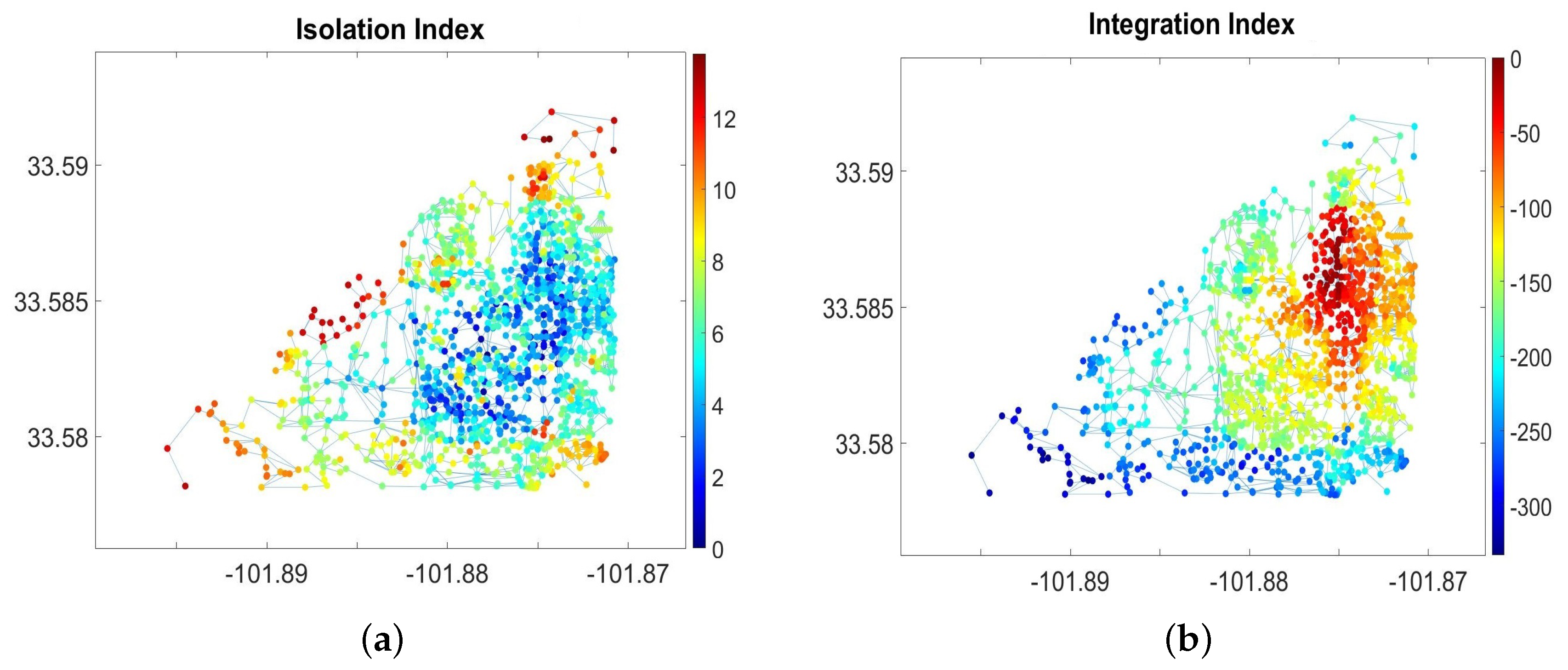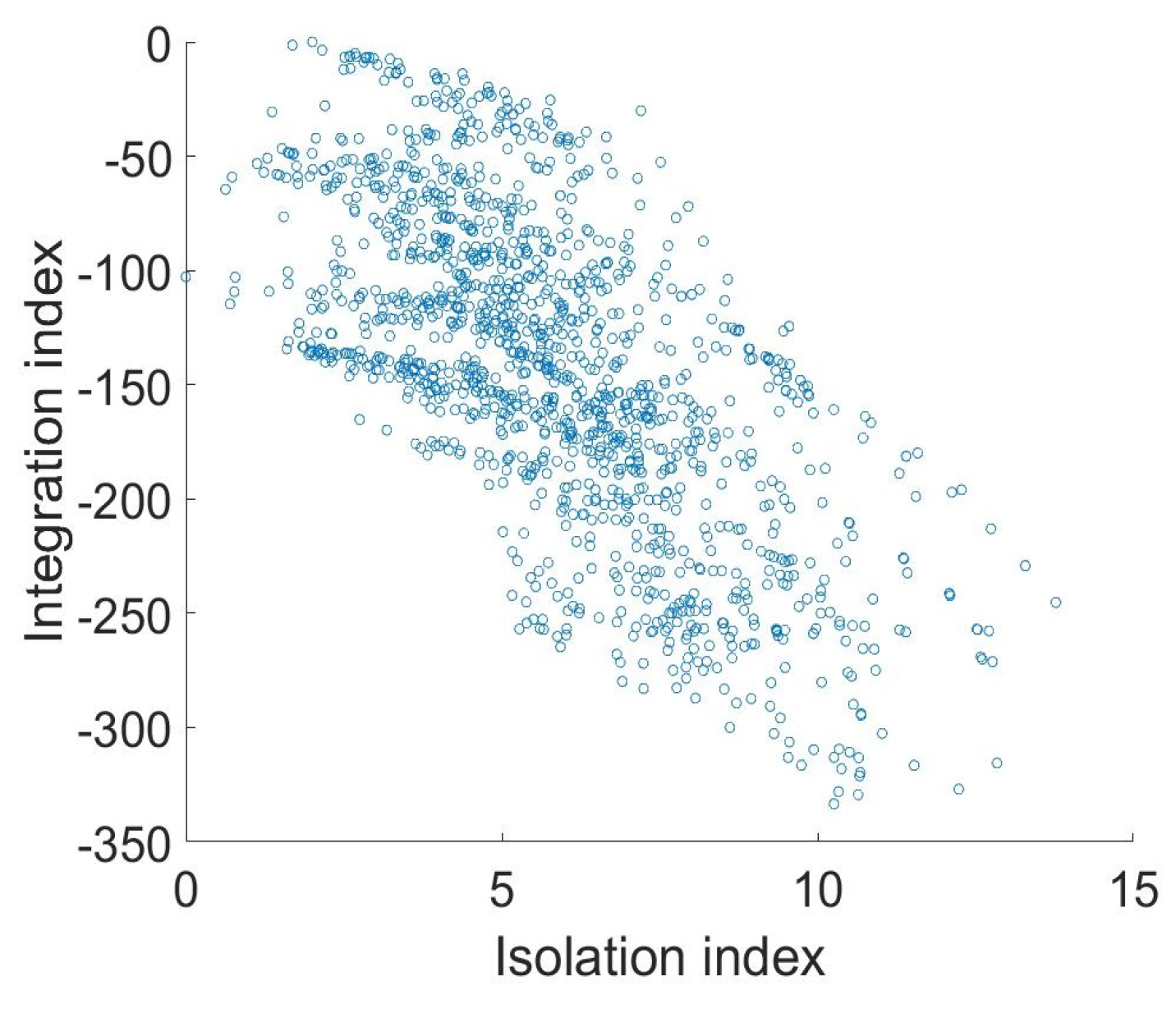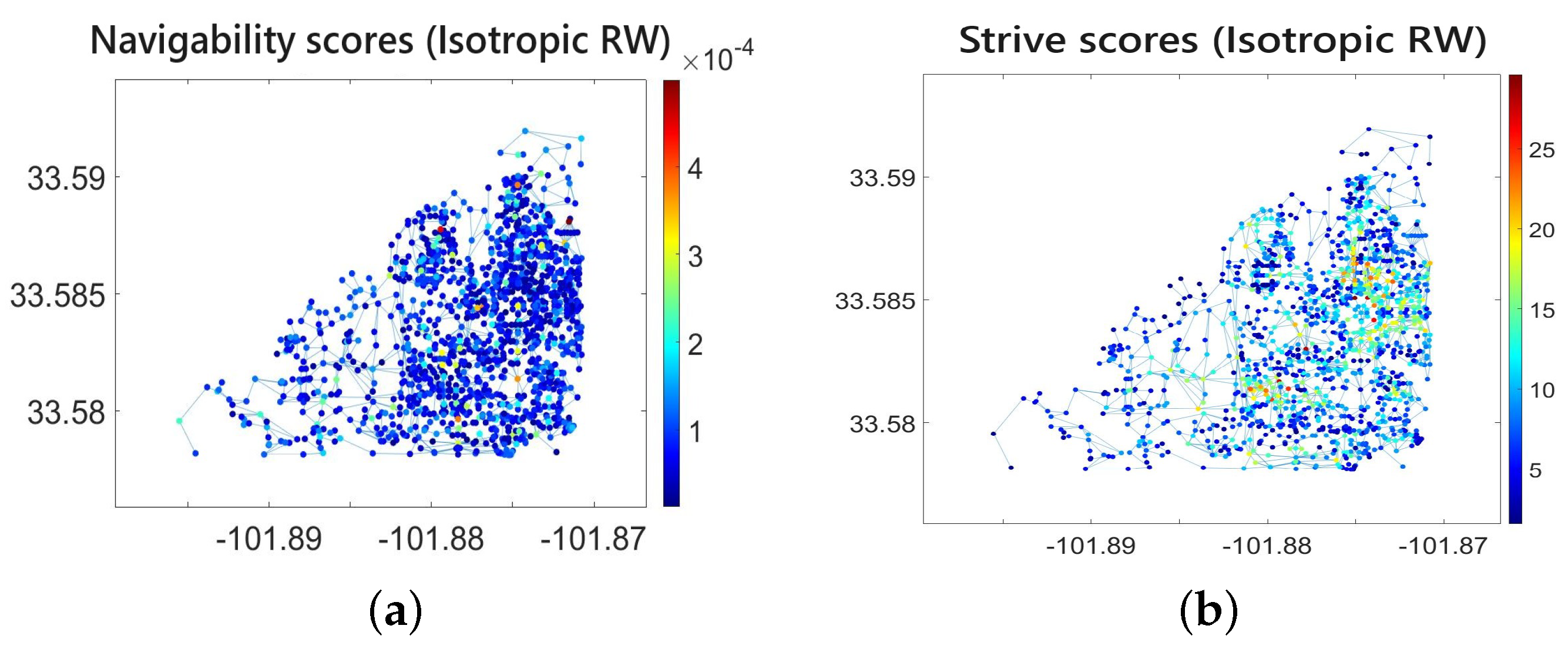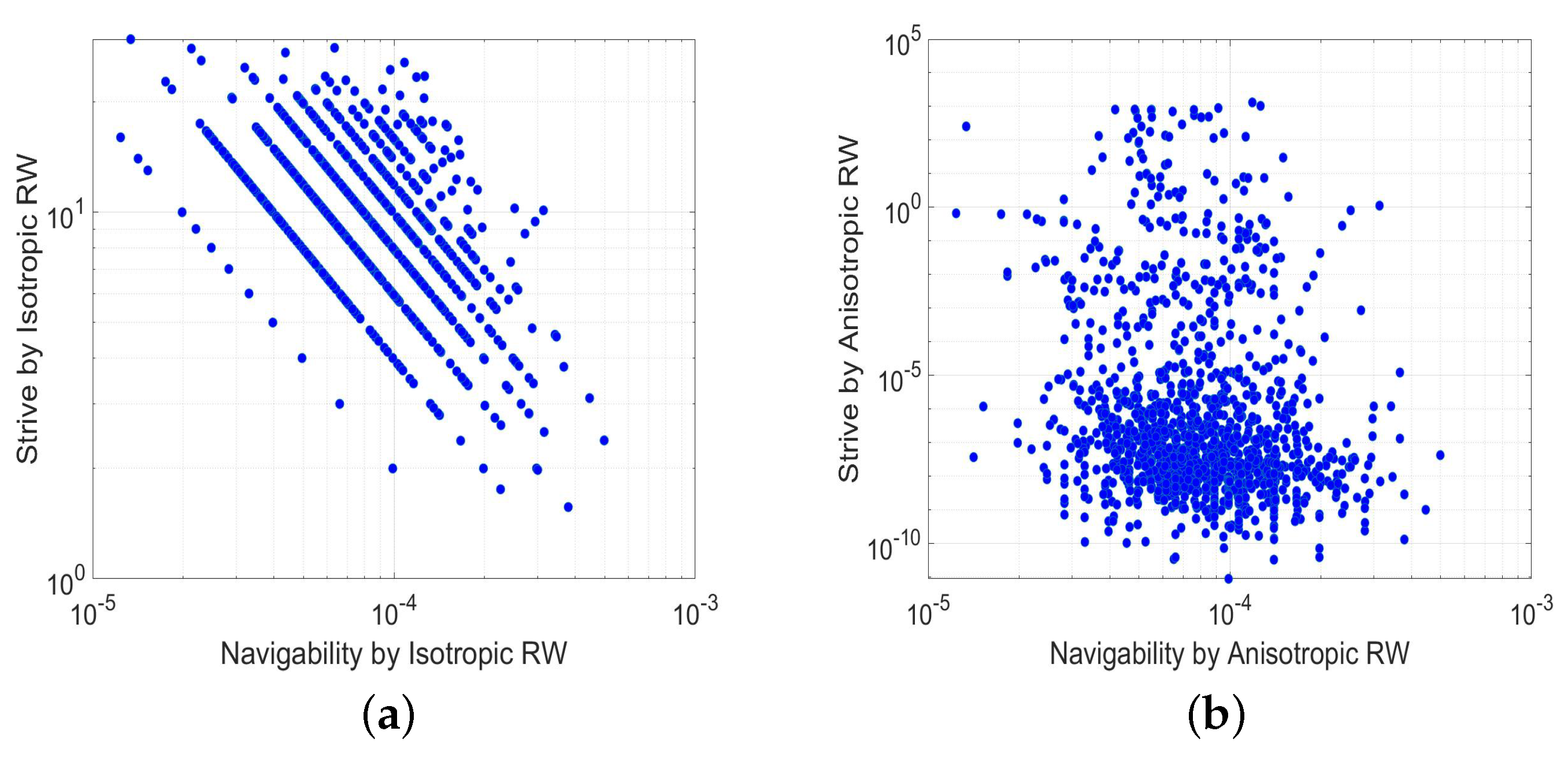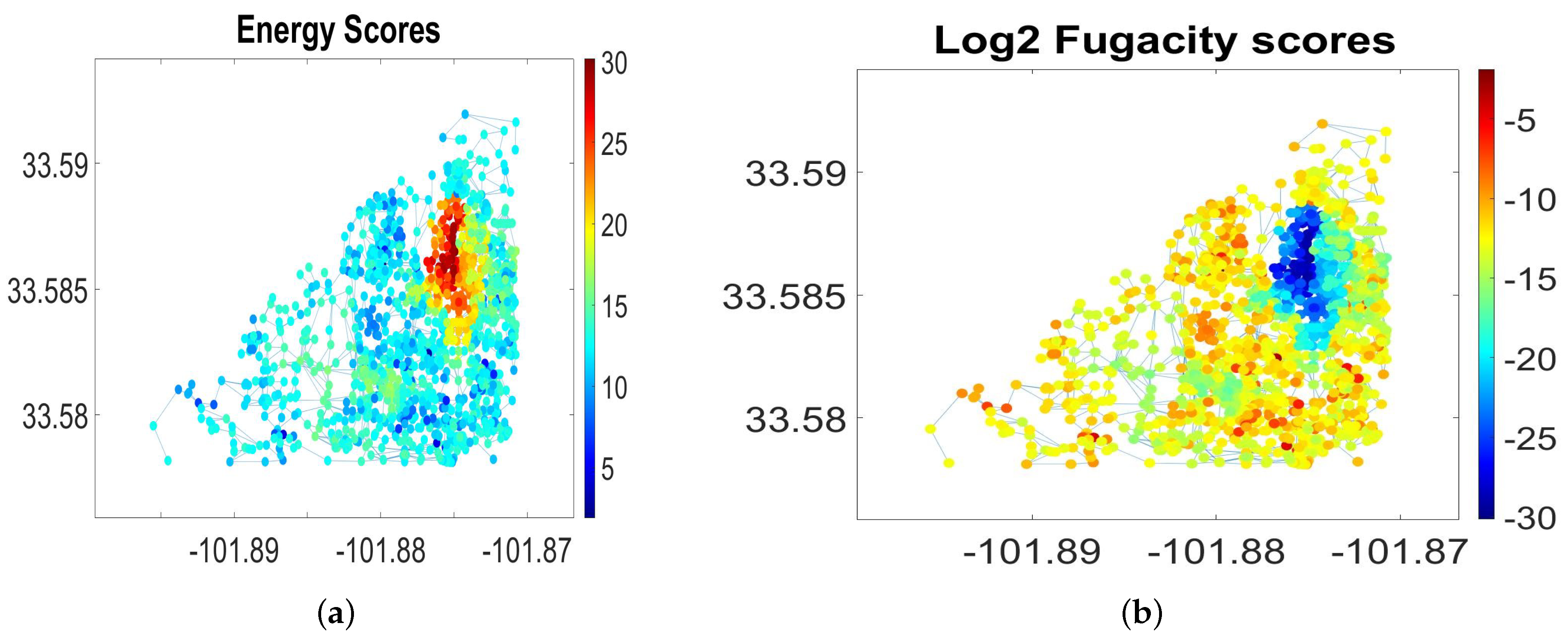1. Introduction—Walkability in a Campus Pedestrian Network
The rapid urbanization and widespread use of cars have resulted in a decline in walking as a primary mode of transportation [
1]. Modern American cities offer very limited opportunities for safe walking. Moreover, a person walking outside an urban park or a recreational area may appear quite suspicious and, as a result, immediately attract police attention. However, in downtown city areas, there is a growing public preference for walking as a means to promote active and healthy lifestyles, while also addressing challenges such as air pollution and traffic congestion [
1,
2].
The physical environment of a university campus provides American students with a rare, if not unique, opportunity to experience walking not only as the most natural mode of transportation but also as a culture that positively impacts cognitive functions like creativity, memory, and concentration [
1,
3]. It also improves community health by promoting social interactions, economic aspects, and environmental impact [
3,
4,
5].
Walkability is a complex concept involving many factors such as proximity, convenience, safety, and comfort for walkers [
6]. Urban forms can encourage or hinder walking activity and, therefore, have a direct impact on accessibility to different places in the built environment. However, the relationship between urban form and walking patterns may show significant differences among different population subgroups, for instance, in terms of gender [
1].
For college students, walkability is crucial as it serves as their main daily transportation mode and aids in achieving physical activity goals. University campuses comprising buildings, outdoor spaces, and support elements, akin to mini-cities, require well-designed pedestrian pathways for overall efficiency [
7,
8]. The campus serves as a pivotal aspect of students’ college experiences, hosting diverse activities [
9] and offering various amenities that promote active lifestyles, influencing students’ physical activity patterns and travel behavior [
10]. The presence of pedestrian-friendly pathways adhering to established norms and promoting overall functionality and sustainability, plays a vital role in facilitating student mobility and connecting key destinations within the campus environment, such as parking lots, bus stops, lecture halls, libraries, and offices. A walkable campus enhances accessibility, reduces vehicle reliance, improves air quality, and fosters a vibrant social atmosphere. Conversely, a dispersed plan hinders walkability, leading to challenges like increased vehicle use, reduced energy efficiency, and limited social interactions [
2]. Among the various types of open spaces, streets serve as essential public realms for students to socialize and engage in daily activities. Studies suggest that visually appealing and comfortable streets can encourage physical activities among students on campus [
11].
In our work, we study the spatial
morphology of a
campus pedestrian network (CPN) comprising 1466 interconnected walkable spaces identified in situ at the
Texas Tech University (TTU) campus located in Lubbock, Texas. Pedestrian networks within an urban space include interconnected walkways, sidewalks, crosswalks, pedestrian signals, and other features that are designed to facilitate pedestrian movement. In the city, they provide safe and convenient access to important destinations, such as schools, parks, shopping centers, and public transportation hubs [
12]. With the use of statistical mechanics of walks defined on the spatial graph representing the pedestrian network, we rigorously define and evaluate the important walkability characteristics, such as isolation, integration, accessibility, and navigability of all places (morphemes) in the CPN.
Cities are often likened to living organisms that must constantly evolve to efficiently manage our communications and adapt to the growing intensity of our daily activities. The spatial configuration of cities plays a key role in generating movement and attracting diverse land uses [
13]. Urban morphology, which focuses on the scientific examination of forms, geometries, and configurations within cities, is crucial in assessing the transportation capacity and walkability of urban environments. Indeed, our daily experiences of moving in the city show that street blockages, traffic incidents, and random roadway repairs often lead to immediate and unpredictable dramatic changes in the usual traffic and pedestrian flows, sometimes affecting areas tens of miles from the place. Vehicle drivers choose alternative routes to avoid potential traffic jams on congested roads, and pedestrians alter their usual walking routes to steer clear of construction zones and areas that seem unpleasant or dangerous to walk through. The spontaneous choice of new paths is largely influenced by chance and is often predetermined by the urban structure. Natural movement theory suggests that people are drawn to highly integrated or connected streets and dense commercial destinations. Moreover, land use itself can increase movement through a multiplier effect by attracting more pedestrians to densely connected streets and bustling commercial areas [
14]. Morphology involves identifying patterns of movement and studying the arrangements of buildings and related walking spaces. Urban design aims to create intentional movement patterns by developing the relevant urban space.
Walkability refers to the ease and convenience of walking within an urban environment, and it is closely tied to urban morphology, which is the physical structure and layout of the city and, therefore, comprehending urban morphology is essential to enhance walkability and improve the quality of urban life [
6]. Walkability studies conducted on university and college campuses or communities with schools can be classified into two main approaches. The first method involves measuring the walkability of existing environments, which can further be divided into units of analysis, such as campus layout, street network organization, and path segments. Various tools are utilized for morphological analysis, including walk scores, surveys, sketch maps, interviews, audits, participatory tools, video recordings, reports, and pedometers. The analysis methods can either focus on quantitative data related to the environment’s characteristics (e.g., the density of people or buildings, intersection density, street connectivity, and sidewalk availability), or rely on the qualitative data obtained from users’ experiences, perspectives, and perceptions of the environment concerning walking [
7,
8,
11,
15,
16,
17,
18,
19,
20,
21]. The majority of campus walkability research focuses on users’ perceptions of route and path characteristics and qualities. This is typically achieved through user participation, surveys, and audits. Considered qualities include path distance, safety, quality, and comfort.
Some studies on campus walkability are conducted at a larger scale, assessing campus layout and spatial organization [
19,
20,
21]. Old and new campus spatial organizations were compared in terms of accessibility and connectivity criteria for campus walkability through video recording and observation in [
8]. Other studies compared old and new campus organizations by creating a new walkability tool that optimizes the walk score method by including facilities’ usage frequency, cure of time-decay block length, and intersection density [
21], or introduce a network distance-based walk score, a new calculation method based on GIS, effectively reflecting the actual walking experience and providing valuable design references for campus improvements [
9]. Several studies have focused on assessing campus layout and spatial organization [
19,
20,
21]. Other studies [
22] utilize the Space Syntax theory [
13] and the analytical tool
depthmapX, specifically the axial analysis method, which involves visual observation, street graphic documentation, and digital simulations to assess students’ walkability.
The design of urban spaces that encourage sustainable practices necessitates new analytical and structural approaches to spatial planning [
12]. Although researchers have extensively studied the characteristics contributing to the walkability of university campuses, there is limited knowledge about how the space morphology of the walking environment, represented by a spatial graph of interconnected walking areas, may influence pedestrian activity by mediating accessibility and navigability to individual spaces, even those located far apart. Conducting further research on the significance of walking space morphology is essential for improving the walkability of university campuses and promoting the overall health of the campus community.
In the present paper, we introduce methods from the statistical mechanics of very long walks in finite-connected undirected graphs to explore the TTU CPN and the most probable walking patterns in the network (
Section 2). The rigorous mathematical approach allows us to evaluate the structural isolation and integration of nodes in a spatial graph (
Section 2.4), assess their accessibility and navigability within the graph (
Section 2.5), and predict possible structural modifications that could drive the evolution of the graph (
Section 2.6).
For constructing the spatial graph of TTU CPN, consisting of 1466 interconnected walking spaces identified in situ, we used a free and open-source cross-platform desktop geographic information system application,
QGIS, which supports viewing, editing, printing, and analysis of geospatial data to create an adjacency matrix of the spatial graph. We also used the graph representation of the city of Lubbock, comprising 10,421 nodes acquired from the
OpenStreetMap service. In
Section 3, we define a scene discussing isolation, integration, and the role of the TTU Campus in the city of Lubbock. In
Section 4, we explain the identification of walkable areas and the generation of the adjacency matrix of the TTU CPN. We apply the statistical mechanics of walks for the morphological analysis of the CPN and present the results in
Section 5. We discuss the results obtained and make our overall conclusion in the last section,
Section 6.
2. Methods: Statistical Mechanics of Walks in Finite-Connected Undirected Graphs
Consider a finite-connected undirected graph
), where
V,
denotes a set of graph vertices, and
denotes a set of edges. The graph
G is specified by an
adjacency matrix, such that
, if
, and
provided
. We further assume that the adjacency matrix allows for the spectral decomposition:
with the ordered set of eigenvalues
. As the graph
G is undirected, its adjacency matrix is symmetric,
, and, therefore, its eigenvalues are real, and the set of corresponding eigenvectors
form an orthogonal system of vectors in
. In particular, the positive vector
,
known as the graph
eigenvector centrality, is the major (Perron–Frobenius) eigenvector of the graph adjacency matrix
A belonging to the maximal eigenvalue
The eigenvector centrality has been in use for more than a century [
23] as the unique measure satisfying natural axioms for a ranking system [
24]. A high eigenvector score means that a node hosts a relatively large share of infinitely long paths available in the graph being connected to many nodes who themselves have high scores.
We introduced thermodynamic (Gibbs [
25]) ensembles of very long walks
in undirected connected graphs that elucidate the graph structure. These ensembles help to quantify accessibility, navigability, and the nodes’ strive in the graph, and evaluate the fugacity of graph nodes—the ease of their withdrawal from the graph—with respect to the entire system of available infinite walks [
26]; this concept has been further studied [
27,
28]. In the following, we briefly discuss the statistical mechanics of very long walks in graphs and their applications for geometrization and navigability of the network, including the new results on transportation network geometrization under the conditions of traffic noise and fluctuating transportation capacity.
2.1. The Microcanonical Ensemble of Walks
The
free energy of walks of length
n (which we will call the
n-walks) in the
microcanonical ensemble of walks (MCE) equals
, where
is the total number of
n-walks available in the graph,
G [
26]. The free energy
grows with
n with the exponential rate—
graph topological entropy (GTE)
as
. Irrelevant to the starting node of the walk, all MCE
n-walks are assigned the
same probability , where the (Boltzmann constant and) temperature
. Therefore, GTE
plays the role of a
chemical potential for the system of infinitely long
equiprobable walks available in the graph,
G.
2.2. Entropic Pressure and Force Associated with the MCE Walks
Graph structural defects (missing nodes and edges) reshape the global mobility patterns in the graph, as they reduce the number (and trajectories) of many long walks, changing the free energy of walks dramatically. Indeed, by withdrawing a node
from the graph, we reduce the number of available MCE-walks
in that, and, consequently, the free energy of
n-walks
decreases by the following amount:
which we call
entropic pressure [
26], as quantifying the displacement of the walker’s mobility pattern from node
to other nodes of the graph if node
i occasionally becomes unavailable. The components of the major eigenvector
can be normalized as the eigenvector centrality scores, i.e., in such a way that
, and then the expression in (
1) takes an elegant form, viz.,
, so that
In the following, we assume that entries of are properly normalized and set
Furthermore, by eliminating an edge from the graph, we reduce the local free energy of the node i by an amount corresponding to the number of -walks available from node adjacent to i in the graph G, which takes the following form in the limit :
0
which we call the
entropic force [
26] emerging from the statistical tendency of random walkers to prefer transitions to the nodes of higher eigenvector centrality scores (i.e., hosting more very long walks), than to those of lower centrality, despite their immediate connectivity (degree).
2.3. The Canonical Ensembles of Walks
In the framework of
canonical ensembles (CNE), many particular long walks available in a graph (
microstates) are lumped to one
macrostate that can be characterized by a stationary distribution, or a density over graph nodes, their subsets, and walks [
27]. The CNEs are formed by
n-walks taken with equal probability, provided that they start at the
same vertex
i,
[
26]. These (random) walks are described by the following irreducible row-stochastic transition matrices:
in which
is the
n-
th order degree of vertex
, in particular,
is the number of edges that are incident to vertex
i in the graph. The random walk
is
isotropic, as the corresponding transitions have no directional bias, and the next node to visit under such a walk is chosen equiprobably among all nearest neighbor nodes available in the graph. All
walks available from node
are chosen with equal probability by other random walks defined by
,
so that immediate transitions may be directionally biased (
anisotropic) toward the neighbor nodes, providing more lengthy paths than others [
26]. The series
converges for infinite walks
to the Ruelle–Bowen random walk (RBW) [
29], viz.,
where
is the entropic force defined in (
3). In the sections that follow, RBW denotes the
anisotropic random walks. The CNE walks are characterized by
equilibrium densities, the major left eigenvectors of the transition matrices
belonging to their maximal eigenvalue
, viz.,
that do not evolve over time. The equilibrium densities (
6) are related to the node’s centrality measures. For example,
where
is the graph edge number, corresponds to the
degree centrality of a node. The stationary distribution for the RBW,
[
30], is the squared eigenvector centrality
of node
i [
23,
24].
The CNE walks defined in a finite-connected graph assign densities (i.e., probability distributions) to all graph nodes and nodal subsets of the graph with respect to a chosen diffusion process [
28]. As a result, uncertainty about the admissible patterns of possible traffic in the network may be partially resolved (as characterized by some probability) [
27], and navigability to a node may be assessed quantitatively with respect to the given graph structure. Moreover, as the probability distributions associated with the CNE walks generate a set of probabilistic metrics [
31,
32] similar to the resistance distance [
33,
34], we can quantitatively assess the
isolation and
integration of a node in the graph structure, as well.
2.4. Evaluating Structural Isolation and Integration by CNE Walks
The natural definition of the graph distance between two vertices in a graph, as the number of steps (graph’s edges) in the shortest path connecting them, can be generalized for random walks, provided that no loops are allowed—meaning the walkers do not revisit nodes they have already visited. Namely, the related distance may be defined as the
expected commute time (CMT) between nodes by such a
self-avoiding random walk [
31,
32]. Then, the accessibility to a node can be assessed by the expected
first passage time (FPT) to the node by a self-avoiding random walk (from a node chosen at random over all nodes of the graph). While the node degree quantifies the local characteristic of a node, referred to as
connectivity, the FPT quantifies the global
connectedness of the node with respect to the entire graph structure, as it takes into account
all possible paths to the node available in the graph,
G, although some paths are more probable than others.
Isolation index of a node (ISL): In [
35], we introduced the
isolation index of a node (ISL), characterizing the node’s accessibility in the graph
G as a relative FPT to the node measured in the decibel scale, viz.,
in which
is the FPT to the node required for a random walker following the
isotropic random walk strategy defined by the transition matrix
. Isotropic random walks are insensitive to the structural heterogeneity, defects, and boundaries of a graph. This is because they take all available edges from a node equiprobably, thereby visiting all graph nodes according to their immediate connectivity (degree) [
32]. The positive high values of the isolation index (
7) are attributed to nodes that are relatively difficult to access in the graph (as measured by the isotropic FPT), and vice versa.
Integration index of a node (INT): The
integration index of a node (INT) is defined as the inverse relative FPT—
—to node
by the
anisotropic RBW random walks
in the decibel scale [
35], viz.,
Definition (
8) is based on the intuition that areas and places of motion—morphemes—
well-integrated into the urban fabric should belong to the majority of possible infinite walks existing in the graph and, therefore, determine the dominant mobility pattern in the transportation network. The RBWs are statistically inclined toward vertices that channel the majority of very long paths available in the graph, while avoiding graph defects and boundaries. According to definition (
8), the node with the minimal FPT by RBWs has a zero score. Well-integrated vertices are characterized by near-zero values of the INT while the weakly integrated nodes have large negative scores.
The calculation of the FPT and the related first-attaining times are discussed in the forthcoming paragraphs.
FPT and Network Geometrization by the CNE Walks: The symmetrization transformation [
27,
32] modifies the Markov chain transition matrix
,
into a symmetric form, viz.,
and then the spectral theorem implies that
is diagonalizable, viz.,
where
is an orthogonal matrix of the orthonormal columns
, the eigenvectors of the transition matrix (
9), and
is a diagonal matrix of real eigenvalues of the transition matrix that we consider to be ordered, viz.,
. To simplify the notation, we drop the index
in the expressions of the present section, such as the symmetrized transition matrix (
9).
The expected number of steps required for a self-avoiding (with no trajectory self-intersections) random walker started at node
to reach node
j for the first time—the
first-hitting-time (FHT)—satisfies the following matrix equation:
The spectral representation of the solution of (
10) [
32,
36] given by
has the form of a
stereographic projection onto projective
-dimensional space
where the stationary distribution of random walks
represented by the polar point
on the unit sphere (see
Figure 1) is a projection point.
The global spectral characteristic of accessibility to a node in the graph is characterized by the
random target access time (RTA), which is the expected length of a random walk with no loops, to reach a random target node, chosen with respect to the stationary distribution of walks
[
32,
36], viz.,
Then, the FPT is the expected length of a random walk with no loops allowed, to reach node
for the first time, starting from a random node, chosen with respect to the stationary distribution
, viz.,
According to (
13), the FPT can be interpreted as a squared norm of the stereographic projection of the vector
,
from the polar point
on an
-dimensional unit sphere
onto a projective space
(see
Figure 1) scaled by the factor
, and correspondingly, each graph node
is characterized by
coordinates in
, viz.,
.
Finally, the CMT time, i.e., the expected length of a
commuting walk between
i and
j with no loops allowed, plays the role of a (Euclidean) distance in the projective space
[
32,
36], viz.,
The average of CMT (
14) over the starting nodes of a walk equals the sum of the FPT to node
j from a random node (
13) and the RTA (
12) from
j to a random node, viz.,
. Finally, the double average of CMT (
14) equals the doubled RTA, viz.,
We can conclude from (
13) and (
14) that random walks equip a connected undirected graph with the Euclidean metric associated with the first-attaining times to the nodes in the corresponding graph structure.
The (Euclidean) CMT distances between
N-graph vertices (
14) can be visualized with the use of the
multidimensional scaling method (MDS) metric, a form of non-linear dimensionality reduction mapping the nodes into a configuration of
N points in an abstract lower-dimensional Cartesian space [
37,
38] that minimizes a residual sum of squares, viz.,
The MDS technique may be used to place the graph nodes into a two- or three-dimensional Euclidean space, such that the distances between nodes are as close to the values as possible, visualizing the level of similarity in the accessibility traits in the spatial graph.
Indeed, the geometric quantities (
13) and (
14) defined above depend dramatically on the chosen random walk
strategy determined by the particular Markov chain transition matrix
,
. In our paper, we denote the FPT (
13) to a node calculated with respect to the isotropic random walks
as
. In our approach, we use this quantity to assess isolation, the
of a node (
7). To evaluate integration, the
of a node (
8), we use the FPT (
13) calculated for the anisotropic RBW random walks (
5) and denoted as
. As the RBW walks (
5) are statistically bound to the graph nodes hosting the majority of very long walks, but repelled from the graph structural defects and boundaries,
, for the walking hubs
i, at the crossroads of very long walks, far apart from the graph structural irregularities, even though their immediate connectivity (degree) is not very high. Alternatively, considering that the probability of finding an RBW-walker in a remote node
, which is not significant for the system of very long walks in the graph, is very low, we can conclude that for such a node, it should be
.
2.5. Assessing Navigability and Strive by the CNE Walks
The more frequent a node, the more predictable the navigator’s location in it [
26,
39]. The CNE walks assigning densities to all nodes (
6) and nodal subsets in the graph allow for quantifying
navigability for graph nodes [
26,
27,
35]. Indeed, the amount of information resolving uncertainty at each step of infinitely long sequences
,
of a Markov chain defined by a transition matrix
W between a finite set of
N states equals the Boltzmann–Gibbs–Shannon entropy [
27,
35,
40,
41],
in which
is a density of states
in the Markov chain, and we assume that
, as usual. The amount of uncertainty (
16) can be represented as a sum of the
predictable information component,
measuring the amount of
apparent uncertainty about the navigator’s location, and the
unpredictable information component
that assesses the amount of
true uncertainty about the walker’s current position, [
26,
28,
42], viz.,
The partition functions
and
, quantifying the amounts of predictable and unpredictable information about the navigator’s location, can be called the
navigability and
strive potentials of node
, respectively [
28], viz.,
The amounts of predictable and unpredictable information (
18) vary over the Markov chain and, for CNE walks defined on a graph, depend on the chosen random walk strategy
, as well as the relative importance of a node for the walks [
28]. It is also worth mentioning that the product
in (
18) is nothing else but a geometric mean of 2-step transition probabilities between
i and
j representing the
time averages over an infinitely long Markov chain. Therefore, the navigability potential
quantifies a chance that node
i may be a
precursor to another node that may occur in the walk
two steps after
i. Consequently, the inverse probability
in the above definition of strive potential equals the
expected time required for a two-step neighborhood exploration of node
i, the neighborhood
exploration time. The more extensive the node’s neighborhood, the longer the time required for exploration, the stronger the strive potential of the node, reducing navigability, i.e., the amount of predictable information about the location of random walkers [
28].
2.6. The Grand Canonical Ensemble of Walks
The
grand canonical ensemble (GCE) of walks describes the statistics of fluctuations of the local growth rate
of the number of distinguishable
n-walks available from a node around the global growth rate,
, predicted by the GTE
playing the role of a “chemical potential” for the entire system of infinitely long equiprobable walks [
26,
27,
28]. The graph is considered open to modifications, similar to a thermodynamic system exchanging energy and particles with a heat bath in thermodynamic equilibrium, as described by Gibbs [
25]. In the thermodynamic limit of infinite walks,
, the Gibbs-type exponential factor, known as node’s
fugacity, describing the
ease of withdrawing a node from the graph considered to be in a thermodynamic equilibrium with the environment [
27], takes the following form:
where we assume that the major eigenvector
is properly normalized, i.e.,
. According to the definition given above, the value of the fugacity parameter is nothing else but the inverse eigenvector centrality, and, therefore, its value is small for the high eigenvector centrality nodes, hosting the majority of infinitely long paths available in the graph, and vice versa (the nodes of high fugacity (low centrality) can easily be withdrawn from the graph).
The GCE probability (to observe a local fluctuation of fugacity at
for the infinite walks,
) takes the form of a
Fermi–Dirac distribution (FDD), which is typical for non-interacting fermions in a single-particle state
i, viz.,
where
is a zero chemical potential, the specific energy that can be absorbed or released in our model due to removing or adding a node from or to the graph, provided it does not affect the entire system of infinite walks in it. The temperature is defined as
, and the energy
of the
i-th state, viz.,
in which
is the
grand canonical potential of the entire system of infinite walks possible in the graph. The GCE probability distribution (
20) quantifies the chances of node
being withdrawn from the graph in proportion to the impact that such a withdrawal would have on the entire system of infinitely long walks. The vertices with the inferior growth rate of the number of very long walks available from them are considered as being loosely integrated into the graph structure; therefore, they might be easily removed from the graph, or, on the contrary, acquire some new connections during the course of graph structural modifications. It is worth mentioning that, as infinite walks in a graph do not interact with each other, our model is statistically similar to a quantum system subjected to the Pauli exclusion principle, which causes the FDD to appear in (
20). Moreover, the FDD for a node’s fugacity also appears as the unique stationary solution for a Fokker–Planck equation describing the continuous-time dynamics of transport under the conditions of traffic noise and fluctuating transportation capacity of graph edges, or a random edge rewiring in a transportation graph when centrality flips its role in the network dynamics [
27,
43,
44]. Indeed, the traffic congestion and consequent accumulation of walkers in a “noisy” transportation network would occur at the nodes of lowest centrality and in structural bottlenecks rather than in hubs handling the majority of traffic under the normal operation regime in the network [
27].
2.7. Transportation Network Geometry Distortion under the Conditions of Traffic Noise and Fluctuating Transportation Capacity
The equilibrium density of CNE walks emerging naturally under the condition of fluid traffic through the network has no meaning if the walkers become stuck in a random traffic jam or experience the occasional traffic slowdown caused by temporary traffic flow disruptions. In the latter case, in the analysis of first-attaining times given in
Section 2.4, we replace the stationary distributions
of random walks (
6) with the GCE-distribution
of the node’s fugacity, defined by (
20). In projective geometry of first-attaining quantities illustrated by
Figure 1, this would correspond to the change in the projection point
by the point denoted as
, which is located in the same positive segment of the unit sphere as
. The corresponding formulas for the first-attaining quantities under the conditions of random traffic flow disruptions are derived from (
13) and (
14), by the following replacement:
, viz.,
and
where
are the eigenvector centrality scores of the graph nodes and
is the grand canonical potential of infinite walks available in the graph. It is worth mentioning that, under the conditions of traffic noise and fluctuating transportation capacity, the first-attaining times (
22) and (
23) defined above may differ significantly from the quantities defined by (
13) and (
14).
3. Scene: Isolation, Integration, Segregation, and the Role of TTU Campus in the City of Lubbock
After the first train steamed to Lubbock on 25 September 1909, its population raised to 4000 in a 10-year period [
45]. Establishing a public research university in Lubbock on 10 February 1923 (under the name of Texas Technological College) with just six buildings and an enrollment of 914 students on 1 October 1925 was another important milestone in the urban development, as the county population had grown rapidly to almost 40,000 by 1930. When the Belt Road
Loop 289 encircled the town by the mid-1960s, Lubbock eventually turned into a city (
Figure 2a). After nightfall on 11 May 1970, portions of Lubbock were struck by a powerful multiple-vortex tornado, resulting in 26 fatalities and damaging nearly 9000 homes and inflicting widespread damage to businesses, high-rise buildings, and public infrastructure [
46]. The primary tornado touched down in southwestern Lubbock and carved an 8.5-mile (13.7 km) path of devastation, encompassing roughly a quarter of the city, with the most destructive impacts were observed in the northeastern part of the city, such as in the Guadalupe barrio, north of 4th Street, along Texas State Highway Loop 289, and near the Lubbock County Club where homes were completely leveled [
47].
Although the tornado reshaped the city’s history, it caused relatively light damage to the campus of Texas Tech University. With its size of 1839 acres, the TTU campus, the second largest contiguous campus in the United States [
48], settled at the city heart, provides the longest pedestrian walkways in Lubbock.
Although the railroad enhanced the city’s status in the early days, it cut the streets, fostering isolation in the nearby areas by dramatically reducing the number of available paths connecting the urban neighborhoods that were located on the opposite sides of the railway tracks. The extensive voids that remained in the northern and eastern parts of Lubbock, following the destructive impact of a tornado, were cut off from the rest of the core city by rails and were not restored for a quite long time. As a result, the city core was literally squeezed out from a bend carved by railways and thrust to the southwest, away from
Loop 289 bounding the city before the mid-1960s (
Figure 2a) [
35]. Defects in connectivity can significantly decrease the number of infinite walks in a city graph, thereby altering the global mobility patterns that can be explained through entropic force. The statistical propensity of very long walks in the graph to preferentially transition to nodes with high eigenvector centrality, hosting numerous infinitely long walks, gives rise to a direction-dependent entropic force [
26].
We utilized the graph representation of Lubbock, TX, obtained from the
OpenStreetMap service [
49] to depict the entropic force occurring in the spatial structure of TTU’s home city. The spatial graph adjacency matrix of Lubbock was constructed using
Python’s lxml library by parsing the raw data and removing structurally disconnected neighborhoods. Lubbock’s linked city graph comprises 10,421 nodes, representing all modes of transportation, including but not limited to residential, secondary, and tertiary roadways, trunk linkages, and highways.
The city’s spatial network of Lubbock is shown in
Figure 2b. The nodes acquired from the
OpenStreetMap service are highlighted according to their scores in Fiedler’s eigenvector (used for the spectral bisection of graphs) belonging to the
second largest eigenvalue of the
-matrix defined in (
3). The Fiedler eigenvector indicates the direction of the steepest descent of the entropic force
across the Lubbock city spatial graph. In exception for a thin zone anchored at the defunct city train station that extends from the historical city center (expelling infinite walks southwest), the entries of Fielder’s eigenvector are zero everywhere (
Figure 2b) [
26]. Needless to say, the TTU cannot follow Lubbock in expanding away from the old city boundaries, as it remains loyal to the former city center with its campus (
Figure 2a). Situated on the boundary of the neighborhoods going downhill (
Figure 2b), the University campus, being a hub for everyday college activities, serves as a bridge between the city of Lubbock’s patterns of isolation and integration (see
Figure 3) [
35].
The isolation and integration patterns, as defined in (
7) and (
8) for the city of Lubbock, acquired from the
OpenStreetMap service [
49] (see
Figure 3), are featured by the shortest FPT values with respect to the isotropic and anisotropic random walks. The high values of the isolation index (
7) (red color in
Figure 3a) are attributed to sprawling urban areas, homing the low-density communities, and auto-dependent urban developments laying outside the Belt Road, apart from the structural focus of the city. Interestingly, statistically defined integration and isolation patterns (
8) and (
7) do not always oppose each other, as some quiet places in sprawling areas of the wealthy southwestern part of Lubbock are relatively isolated, yet well-integrated into the system of very long paths possible in Lubbock’s spatial graph (
Figure 3b).
The integration index of a place defined by (
8) highlights a relative share of very long paths hosted by the place in the city street map. Places hosting the lion’s share of very long walks feature global
mobility patterns in urban structures, playing the role of natural social and economic hubs of the city. Although located within the historic city borders, areas such as those in the northeastern portion of the city that are shut off from the center by commercial trains, significantly reducing the number of infinitely long pathways, are only sporadically incorporated into the city fabric. They are characterized by the
large negative numbers of integration indexes (
8) and colored in dark blue in
Figure 3b. Due to the structural imbalance fostered by railways, relatively isolated sprawling areas of the southwest are able to statistically accumulate the bulk of possible infinite routes and move Lubbock’s mobility patterns from the historic core to the southwest suburbs;
integrated isolation is not an oxymoron, but the home of the wealthiest people. The northeastern portions of Lubbock, cut off by railways and characterized by very low values of the integration index (dark blue in
Figure 3b), align with the historical segregation patterns of spatial and land division, as well as ownership, early in the 20th century. This was when black workers and braceros (Mexican workers), as well as their families, settled in labor camps, in what is known today as Guadalupe Park and the surrounding areas. Numerous buildings throughout Lubbock were damaged beyond repair and were demolished after the tornado of 1970, including the northwestern section of downtown and the predominantly Hispanic neighborhood of Guadalupe in the northeast [
50]. The Lubbock Urban Renewal Agency rebuilt the largely destroyed Guadalupe neighborhood, although progress was slow for many years before substantial reconstruction occurred [
46,
47,
50]. Today, most of the Hispanic–Latino descent communities are still located in the northeast, living under the most pressuring social and economic issues [
51].
4. Campus: Walkable Area Identification and Adjacency Matrix Generation
The original TTU campus layout and architecture of 1925 reflected the Spanish Renaissance Revival style. The campus continued to expand during the 1930s, with the addition of new academic and administrative buildings, such as the iconic Engineering Key and the Administration Buildings. The campus development slowed down during World War II due to budget constraints, but resumed after the war, and flourished in the 1950s and 1960s when new academic buildings, dormitories, and sports facilities were constructed. The university’s growth was accompanied by a shift in architectural styles, moving away from the Spanish Renaissance Revival to more modern designs. From the 1970s to 1990s, the campus development continued to reflect a blend of modern architecture and a commitment to preserving historical buildings. In the last decades, the campus underwent major transformations, with new state-of-the-art academic buildings, research centers, and student housing complexes, and presently continues to evolve with a focus on sustainability, technology, and innovation. Ongoing projects include the construction of modern research facilities, improvements to student amenities, and the integration of green spaces and outdoor areas for the campus community.
To assess the spatial morphology of the campus and its implications for pedestrian accessibility, the walkable spaces across the campus were identified through the utilization of QGIS. These areas encompassed various pedestrian pathways, including sidewalks and the footprints of buildings (see
Figure 4a). By meticulously defining these walking spaces, we aimed to capture the spatial context of pedestrian movement within the campus environment. One innovative aspect of our methodology was the inclusion of buildings within the defined walkable areas. Recognizing that buildings often serve as connective elements within the campus, we delineated pathways that incorporated building structures. This acknowledgment was rooted in the understanding that certain buildings facilitate movement between different parts of the campus.
Each identified walking space was assigned a distinct identifier, resulting in the manual delineation of 1466 individual features or shape files within the QGIS software(3.34.1). These walkable zones were subsequently interconnected, reflecting the interplay between pedestrian paths and building structures. A pivotal step in our methodology involved conducting an intersection analysis between the designated walking spaces and the openings of buildings. This analysis was imperative as it directly influenced the accessibility and navigational feasibility of the pedestrian routes. By executing the intersection operation, we aimed to uncover critical points of interaction within the campus layout.
Following the intersection analysis, an adjacency matrix was generated. This matrix facilitated the visualization of relationships between different shape features identified in the walkable zones. Each row and column of the matrix represented a distinct shape feature, and the matrix elements denoted the presence or absence of intersections. Since pedestrian traffic in each area is possible in both directions, the spatial graph representing the campus morphology is undirected. In
Figure 4b, we show a tree representation of the obtained spatial graph rooted at Memorial Circle, the most connected place on the TTU campus. Although the spatial graph structure of the TTU campus is ample with cycles (and, therefore, is not a tree, formally speaking), its tree representation shown in
Figure 4b exhibits the profound depth of the spatial morphology (up to 26 levels) and the structural heterogeneity of the graph, revealing itself in the presence of many connected clusters, as well as the multiple structural bottlenecks.
6. Discussion and Conclusions
The city constitutes one of the most complex artificial networks created by humans to foster life, improve security, and facilitate communication, and it will determine our social and economic well-being for generations to come. A modern city includes functionally distinct areas such as the university campus, which offers international and local students a safe, car- and gun-free pedestrian zone for studying, living, and interacting with each other in a friendly environment.
Pioneers in urban space studies have delved into the intricate relationship between urban morphology and pedestrian experiences. Bill Hillier’s space syntax theory [
13] examined how building and block structures impact pedestrian movement from a socio–spatial viewpoint. Christopher Alexander’s “Pattern Language” [
56] introduced design patterns aimed at enhancing pedestrian interactions with the built environment. Jeff Speck’s “Walkable City” [
57] advocated for walkable urban environments through actionable steps. Kevin Lynch’s visual and social approaches identified key elements that shape how pedestrians perceive urban spaces, emphasizing vitality and access [
58]. Jan Gehl’s work [
59] offered multi-faceted perspectives, focusing on enhancing pedestrian vitality, integrating visual and functional elements, and addressing climatic considerations. Together, these visionaries contributed to a comprehensive understanding of how urban form, design, and various parameters intertwine to influence the way pedestrians navigate and experience urban spaces [
14].
The TTU campus exists and functions within a complex dynamic environment of the city, where all movements are carried out mainly by cars. The city of Lubbock has its own structural dynamics, driven by an entropic force that is pushing the urban fabric away from the railroad tracks, which have lost their social significance since the cessation of passenger rail service. As a result of being repelled from the railway tracks, Lubbock is running to the southwest, leading to a process of urban decay and disintegration in what was once a vibrant city center. This structural imbalance was further exacerbated by the Lubbock tornado, which virtually devastated the northeastern part of the city in May 1970. As a result, “
Old Lubbock, the Lubbock inside of Loop 289, is trapped in decline” [
51], with its neighborhoods experiencing a loss in population, its schools closing, its roads deteriorating, and a growing number of residents falling into poverty. Due to fewer commercial options and a heightened sense of isolation among residents, isolation in large cities deteriorates economic prospects and fuels poverty and crime [
54]. Creating more roads only exacerbates the issue in the long run, as expanding road capacity eventually leads to even more traffic and sprawl. Although the structural isolation described above can be countered by building new city ring roads that encircle isolated areas and cut-off communities [
39], this approach has its drawbacks. By facilitating access to the southwest sprawls, the expansion of Lubbock’s road network (such as the proposed Loop 88 that would encircle the expanding metropolis in Wolfforth by 2030) would reduce isolation. However, it would also encourage more sprawl and traffic, further worsening the social and economic circumstances in the Northeast and downtown areas.
The quick development of south and west Lubbock creates the appearance of a bustling metropolis; this growth was largely facilitated by infrastructural improvements made along Milwaukee Avenue. However, over time, there has been an accumulation of money and resources outside of Loop 289, from both public and private sources [
51]. In our work, we argue that as long as the city structure remains unchanged, with much of the urban fabric in the northeast cut off from the main city, Lubbock will continue its expansion towards the southwest. In [
51], it was suggested that Old Lubbock’s decline “
is not because of inherent economic flaws, but because Lubbock’s policy orientation is currently shaped to cause its descent”. In our work, we demonstrated that the real reason for the decline of the area inside of Loop 289 is more profound, rooted in urban structural flaws. These flaws are the result of railroad tracks dividing the city core and the devastating impact of the 1970s tornado, which damaged and delayed the development of the northeastern part of the city for decades, while policy orientation simply follows the urgency of the times and the pace of life. In this regard, the TTU campus, a large pedestrian zone of permanent social activity located inside of Loop 289, close to the historical city center, plays an important role for the city’s future development, as it revives the city core and naturally mediates between Old Lubbock and its “new”, runaway sprawling body. Southwest Lubbock is now more socioeconomically stratified than it has ever been as a result of the concentration of wealth and resources in one area [
51].
East Lubbock, with an industrial buffer zone to maintain Jim Crow segregation, was a racially divided area of the city from 1890 to the twenty-first century. The statute that prohibited Black and Hispanic residents from residing on Lubbock’s east and north sides was not officially removed until 2006—nearly a century after the 1917 Buchanan v. Warley case, in which the Supreme Court ruled that residential segregation was unconstitutional [
60]. Population reduction makes it evident that Lubbock’s north and east are experiencing severe urban deterioration and economic downturn. There was a 1.5% increase in the population in the west and a 1.6% increase in the south of the city. In light of the 0.8% increase in the north and the 0% growth in East Lubbock, these figures are astounding [
60]. Urgent actions to modify the urban structure must be taken to stop the urban decay process.
Our analysis of the TTU CPN as a self-evolving DCN, in which the various walking areas interact with one other at distinct and varied temporal and spatial scales through persistent pedestrian mobility patterns, makes use of the statistical mechanics of walking in connected undirected graphs [
26,
27,
28].
The evolution of the DCN may follow different routes. While in the complex network theory [
61], the fittest “
winner” takes all in the evolution of boundlessly growing graphs,
, and the preferential attachment mechanism, colloquially known as the
Matthew effect [
62], pulls the ever-growing graphs to Bose–Einstein statistics and eventually concludes at the Bose–Einstein condensation at a single super-hub [
63]. From an evolutionary perspective, such a topological phase transition from Matthew’s “
rich-get-richer” phase to a “
winner-takes-all” phase can be interpreted as an act of
stabilizing selection, which limits individual variability through mechanisms of accumulated advantage [
26,
64].
However, if the DCN is open to random structural modifications, another thermodynamic limit of infinitely long walks,
, may become important. Then, the Fermi–Dirac statistics of very long walks in the graph display the DCN’s development, which neither requires network expansion nor predicts any eventual stage of its structural history. Graph evolution based on Fermi–Dirac statistics aligns more closely with
diversifying selection, which refers to population genetic changes that favor extreme trait values over normative values during periods of rapid environmental change [
64]. Thus, the nodes with minimal centrality, sporadically woven into the network’s structure, are likely to exhibit its structural alterations. Abandoning the principle of accumulated advantage, we may put forward a recurrent graph-growing algorithm, in which new edges are sequentially added to the network at random, targeting nodes based on their current fugacity values. This approach improves their integration into the structural fabric of the networks and strengthens the overall cohesiveness of the graph [
26].
The methods of statistical mechanics of walks discussed in our paper allow for the rigorous quantitative assessments of accessibility, navigability, isolation, and integration of individual places in the complex fabric of large urban environments explored by the different modes of transportation—by car or afoot. Our approach may be implemented not only for the detailed automated expertise of large spatial city graphs, but also for comparing the different graphs representing diverse urban environments and functional zones, such as university campuses.
Further research is needed to focus on the evolution of CPNs using the proposed diversifying graph-growing algorithms, optimizing a node’s connectivity and graph cohesiveness at each step.
